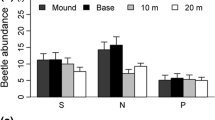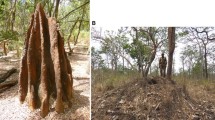Abstract
Termite mounds are a widespread feature in most African savannas. These structures exhibit high nutrient contents and often host a special vegetation composition. In this study, we analysed mound distribution patterns of a fungus-growing termite species, Macrotermes michaelseni, an important ecosystem engineer in the savannas of Namibia. Inhabited mounds taller than 0.7 m were regularly distributed. We view this pattern as a result of intraspecific competition. The heights of mounds taller than 0.7 m were correlated positively with their distance, such that mounds closer together, i.e. up to inter-mound distances of approximately 50 m, tended to be smaller than average. This indicates that intraspecific competition for foraging areas controls mound distribution pattern and colony size. Differences between mound heights increased on the spatial scale up to inter-mound distances of 80 m. We assume that the foundation of new colonies is only possible in unoccupied patches. In such patches, young colonies are able to occur close together as they have a relatively low foraging demand and therefore a low spatial demand. In contrast, their critical distance to taller colonies with higher foraging demands is rather large, which leads to the observed increasing difference of mound heights with increasing distances between them.









Similar content being viewed by others
References
Abe T. and Darlington J.P.E.C. 1985. Distribution and abundance of a mound-building termite, Macrotermes michaelseni, with special reference to its subterranean colonies and ant predators. Physiol. Ecol. Japan 22: 59-74
Baddeley A. and Turner R. 2005. spatstat: An R package for analyzing spatial point patterns. J. Stat. Softw. 12: 1-42
Barot S., Gignoux J. and Menaut J.C. 1999. Demography of a savanna palm tree: predictions from comprehensive spatial pattern analyses. Ecology 80: 1987-2005
Bodot P. 1961. La destruction des termitières de Bellicositermes natalensis Hav., par une fourmi, Dorylus (Typhlopone) dentifrons Wasmann. C.R. Hebd. Acad. Sci. 253: 3053-3054
Bodot P.P. 1967. Étude écologique des termites des savanes de basse Côte-D’Ivoire. Insect. Soc. 14: 229-258
Brandl R., Hacker M., Epplen J.T. and Kaib M. 2005. High gene flow between populations of Macrotermes michaelseni (Isoptera, Termitidae). Insect. Soc. 52: 344-349
Chiu S.N. 2007. Correction to Koen’s critical values in testing spatial randomness. J. Stat. Comput. Sim. 77: 1001-1004
Collins N.M. 1981. Populations, age structure and survivorship of colonies of Macrotermes bellicosus (Isoptera: Macrotermitinae). J. Anim. Ecol. 50: 293-311
Crist T.O. and Wiens J.A. 1996. The distribution of ant colonies in a semiarid landscape: implications for community and ecosystem processes. Oikos 76: 301-311
Dangerfield J.M., McCarthy T.S. and Ellery W.N. 1998. The mound-building termite Macrotermes michaelseni as an ecosystem engineer. J. Trop. Ecol. 14: 507-520
Darlington J.P.E.C. 1982. The underground passages and storage pits used in foraging by a nest of the termite Macrotermes michaelseni in Kajiado, Kenya. J. Zool. 198: 237-247
Darlington J.P.E.C. 1985. Attacks by doryline ants and termite nest defenses (Hymenoptera; Formicidae; Isoptera; Termitidae). Sociobiology 11: 189-200
Darlington J.P.E.C. 1990. Populations in nests of the termite Macrotermes subhyalinus in Kenya. Insect. Soc. 37: 158-168
Darlington J.P.E.C. and Dransfield R.D. 1987. Size relationships in nest populations and mound parameters in the termite Macrotermes michaelseni in Kenya. Insect. Soc. 34: 165-180
Darlington J.P.E.C., Zimmerman P.R. and Wandiga S.O. 1992. Populations in nests of the termite Macrotermes jeanneli in Kenya. J. Trop. Ecol. 8: 73-85
Diggle P.J. 2003. Statistical Analysis of Spatial Point Patterns. Arnold, London. 159 pp
Dungan J.L., Perry J.N., Dale M.R.T., Legendre P., Citron-Pousty S., Fortin M.J., Jakomulska A., Miriti M. and Rosenberg M.S. 2002. A balanced view of scale in spatial statistical analysis. Ecography 25: 626-640
Fisher J.B., Trulio L.A., Biging G.S. and Chromczak D. 2007. An analysis of spatial clustering and implications for wildlife management: a burrowing owl example. Environ. Manag. 39: 403-411
Fisher M. 1993. Fine-scale distributions of tropical animal mounds - a revised statistical analysis. J. Trop. Ecol. 9: 339-348
Haines-Young R. 2005. Landscape pattern: context and process. In: Issues and Perspectives in Landscape Ecology (Wiens J.A. and Moss M.R., Eds), Cambridge University Press, Cambridge. pp 103-111
Illian J., Penttinen A., Stoyan H. and Stoyan D. 2008. Statistical Analysis and Modelling of Spatial Point Patterns. J. Wiley & Sons Ltd., Chichester. 534 pp
Josens G. and Soki K. 2010. Relation between termite numbers and the size of their mounds. Insect. Soc. 57: in press. DOI: 10.1007/s00040-010-0085-2
Kaib M., Mikus S., Bagine R.K., Stadler J. and Brandl R. 1997. Distribution of Macrotermes michaelseni colonies on different spatial scales. Mitt. Dtsch. Ges. Allg. Angew. Ent. 11: 189-192
Kaib M., Hacker M. and Brandl R. 2001. Egg-laying in monogynous and polygynous colonies of the termite Macrotermes michaelseni (Isoptera, Macrotermitidae). Insect. Soc. 48: 231-237
Kaib M., Jmhasly P., Wilfert L., Durka W., Franke S., Francke W., Leuthold R.H. and Brandl R. 2004. Cuticular hydrocarbons and aggression in the termite Macrotermes subhyalinus. J. Chem. Ecol. 30: 365-385
Korb J. and Linsenmair K.E. 2001a. The causes of spatial patterning of mounds of a fungus-cultivating termite: results from nearest-neighbour analysis and ecological studies. Oecologia 127: 324-333
Korb J. and Linsenmair K.E. 2001b. Resource availability and distribution patterns, indicators of competition between Macrotermes bellicosus and other macro-detritivores in the Comoé National Park, Côte d’Ivoire. Afr. J. Ecol. 39: 257-265
Lepage M. 1984. Distribution, density and evolution of Macrotermes bellicosus nests (Isoptera: Macrotermitinae) in the north-east of Ivory Coast. J. Anim. Ecol. 53: 107-117
Lepage M. and Darlington J.P.E.C. 2000. Population dynamics of termites. In: Termites: Evolution, Sociality, Symbioses, Ecology (Abe T., Bignell D.E. and Higashi, M., Eds), Kluwer Academic Publishers, Dordrecht. pp 333-361
Levin S.A. 1992. The problem of pattern and scale in ecology. Ecology 73: 1943-1967
Levings S.C. and Adams E.S. 1984. Intra- and interspecific territoriality in Nasutitermes (Isoptera: Termitidae) in a Panamanian mangrove forest. J. Anim. Ecol. 53: 705-714
Mendelsohn J.M., Jarvis A.M., Roberts C.S. and Robertson T. 2003. Atlas of Namibia: a Portrait of the Land and Its People. New African Books (Pty) Ltd, Cape Town. 200 pp
Meyer V.W., Braack L.E.O., Biggs H.C. and Ebersohn C. 1999. Distribution and density of termite mounds in the northern Kruger National Park, with specific reference to those constructed by Macrotermes Holmgren (Isoptera: Termitidae). Afr. Entomol. 7: 123-130
Meyer V.W., Crewe R.M., Braack L.E.O., Groeneveld H.T. and van der Linde M.J. 2000. Intracolonial demography of the mound-building termite Macrotermes natalensis (Haviland) (Isoptera, Termitidae) in the northern Kruger National Park, South Africa. Insect. Soc. 47: 390-397
Millennium Ecosystem Assessment 2005. Ecosystems and Human Well-Being: Desertification Synthesis. World Resources Institute, Washington, DC
Mills A.J., Milewski A., Fey M.V., Groengroeft A. and Petersen A. 2009. Fungus culturing, nutrient mining and geophagy: a geochemical investigation of Macrotermes and Trinervitermes mounds in southern Africa. J. Zool. 278: 24-35
Moe S.R., Mobæk R. and Narmo A.K. 2009. Mound building termites contribute to savanna vegetation heterogeneity. Plant Ecol. 202: 31-40
Perry G.L.W., Miller B.P. and Enright N.J. 2006. A comparison of methods for the statistical analysis of spatial point patterns in plant ecology. Plant Ecol. 187: 59-82
Pomeroy D.E. 1983a. Distribution and abundance of large termite mounds in a semi-arid area of southern Kenya. Kenya J. Sci. Technol. Ser. B 4: 77-87
Pomeroy D.E. 1983b. A striking increase in a population of termite mounds in eastern Kenya. Kenya J. Sci. Technol. Ser. B 4: 89-96
Pomeroy D. 2005. Dispersion and activity patterns of three populations of large termite mounds in Kenya. J. East Afr. Nat. Hist. 94: 319-341
R Development Core Team 2008. R: A Language and Environment for Statistical Computing. R Foundation for Statistical Computing, Vienna. http://www.R-project.org
Schooley R.L. and Wiens J.A. 2001. Dispersion of kangaroo rat mounds at multiple scales in New Mexico, USA. Landscape Ecol. 16: 267-277
Schuurman G. 2006. Foraging and distribution patterns in a termite assemblage dominated by fungus-growing species in semi-arid northern Botswana. J. Trop. Ecol. 22: 277-287
Schuurman G. and Dangerfield J.M. 1997. Dispersion and abundance of Macrotermes michaelseni colonies: a limited role for intraspecific competition. J. Trop. Ecol. 13: 39-49
Spain A.V., Sinclair D.F. and Diggle P.J. 1986. Spatial distributions of the mounds of harvester and forager termites (Isoptera: Termitidae) at four locations in tropical North-Eastern Australia. Acta Oecol. Oecol. Gen. 7: 335-352
Stoyan D. and Stoyan H. 1994. Fractals, Random Shapes and Point Fields. J. Wiley & Sons Ltd., Chichester. 406 pp
Turner J.S. 2000. Architecture and morphogenesis in the mound of Macrotermes michaelseni (Sjöstedt) (Isoptera: Termitidae, Macrotermitinae) in northern Namibia. Cimbebasia 16: 143-175
Whitford W.G. 1991. Subterranean termites and long-term productivity of desert rangelands. Sociobiology 19: 235-243
Wiegand T. and Moloney, K.A. 2004. Rings, circles, and null-models for point pattern analysis in ecology. Oikos 104: 209-229
Wiegand T., Gunatilleke S., Gunatilleke N. and Okuda T. 2007. Analyzing the spatial structure of a Sri Lankan tree species with multiple scales of clustering. Ecology 88: 3088-3102
Wood T.G. and Lee K.E. 1971. Abundance of mounds and competition among colonies of some Australian termite species. Pedobiologia 11: 341-366
Wood T.G. and Sands W.A. 1978. The role of termites in ecosystems. In: Production Ecology of Ants and Termites (Brian M.V., Ed), Cambridge University Press, Cambridge. pp 245-292
Acknowledgments
We gratefully thank Elfi and Johan Kotze for support and permission to work on their farm as well as Joachim Nopper for his field assistance. The Ministry of Environment and Tourism (MET) of Namibia granted the permit to conduct this study. It was funded by the German Ministry of Education and Research (BMBF) within the framework of BIOTA Southern Africa (01LC0624J) and Helmholtz-EOS. We are grateful to Dr. Klaus Birkhofer for helpful suggestions during an early stage of this manuscript. Prof. Manfred Kaib and two anonymous referees helped to improve the manuscript.
Author information
Authors and Affiliations
Corresponding author
Rights and permissions
About this article
Cite this article
Grohmann, C., Oldeland, J., Stoyan, D. et al. Multi-scale pattern analysis of a mound-building termite species. Insect. Soc. 57, 477–486 (2010). https://doi.org/10.1007/s00040-010-0107-0
Received:
Revised:
Accepted:
Published:
Issue Date:
DOI: https://doi.org/10.1007/s00040-010-0107-0




